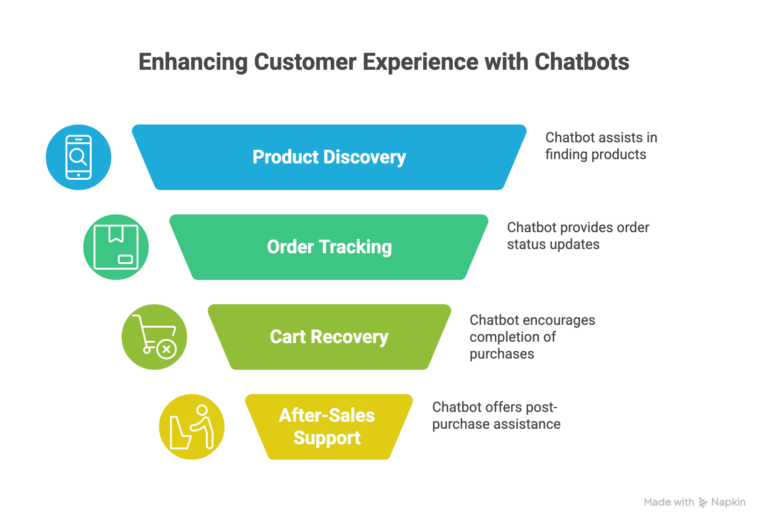Greetings! I'm Aneesh Sreedharan, CEO of 2Hats Logic Solutions. At 2Hats Logic Solutions, we are dedicated to providing technical expertise and resolving your concerns in the world of technology. Our blog page serves as a resource where we share insights and experiences, offering valuable perspectives on your queries.

Quick Summary
AI chatbots are transforming Saudi e-commerce by providing 24/7 customer support in Arabic, integrating with WhatsApp (where your customers already are), and cutting support costs by up to 65%. With Saudi Arabia’s e-commerce market growing at 12.8% yearly, businesses using AI chatbots are gaining a massive competitive edge. This guide shows you exactly how to join them.
Let me ask you something: Have you ever lost a sale because a customer had a question at 2 AM and nobody was there to answer?
Or maybe you’ve watched your support team drown during Ramadan sales, unable to keep up with the flood of messages?
If you’re nodding your head right now, you’re not alone. And here’s the good news: AI chatbots can fix this problem.
Saudi Arabia’s online shopping scene is absolutely exploding right now. We’re talking USD 222.9 billion market size, growing faster than almost anywhere else in the world. But here’s the thing, Saudi customers have super high expectations. They want answers NOW. They want to chat in Arabic. And they definitely want to message you on WhatsApp, not fill out some boring contact form.
Traditional customer support just can’t keep up anymore. That’s where AI chatbots come in.
Why Saudi E-commerce Businesses Are Adopting AI Chatbots
Think about this for a second: Over 70% of Saudi customers prefer talking to businesses on WhatsApp. Not email. Not phone calls. WhatsApp!
And they expect you to respond immediately, whether it’s 3 PM on Tuesday or 11 PM on Friday night.
Hiring enough people to provide 24/7 support in multiple languages? That’s crazy expensive. But a chatbot? It never sleeps, never takes breaks, and can talk to thousands of customers at the same time.
PRO TIP: The AI chatbot market in Saudi Arabia is projected to hit USD 1.2 billion by 2033. This isn’t some future trend; it’s happening RIGHT NOW. Early adopters are already seeing huge advantages over their competitors.
Here’s what’s driving this boom:
- Saudi consumers are tech-savvy: Over 99% internet penetration means everyone’s shopping online
- Mobile-first culture: People are shopping from their phones, not desktops
- High expectations: Customers want instant answers, or they’ll bounce to your competitor
- WhatsApp dominance: It’s the #1 way people communicate with businesses
The Real Benefits (With Actual Numbers!)
Let me show you what happens when Saudi e-commerce businesses add AI chatbots:

Your Store Never Closes
Imagine having a super-smart employee who works 24/7/365, never calls in sick, and responds to customers in seconds. That’s basically what a chatbot does.
A real Middle Eastern electronics store added a bilingual chatbot and saw its response time drop from hours to under 1 minute. Think about that, customers got instant help instead of waiting around.
You Save Serious Money
Here’s where things get interesting. That same electronics store cut its support tickets by 65% within just 60 days.
Translation? They handled way more customers without hiring more support staff. In fact, AI chatbots can reduce customer support costs by up to 65% overall. During busy seasons like Ramadan or Black Friday, when everyone else is scrambling to hire temporary help, your chatbot just… handles it.
WARNING: Don’t launch your chatbot for the first time during your busiest shopping season! Test it during slower periods first. You don’t want to discover problems when the stakes are highest.
More Sales, Happier Customers
That electronics store I mentioned? They didn’t just save money, they increased their conversion rate by 18% within two months.
Why? Because when customers get instant, helpful answers, they actually complete their purchases instead of abandoning their carts.
Studies show that 78% of customers are more likely to buy again from brands that personalize their experience. And guess what chatbots are really, really good at? Yep, personalization.
Ready to see these results in your own store?
Why Arabic Support Isn’t Optional
Here’s where a lot of international e-commerce platforms mess up in Saudi Arabia: They think Google Translate is good enough for Arabic support.
It’s not. Not even close.
Saudi customers don’t just speak “Arabic”, they speak Gulf dialects, they mix in English words, and younger shoppers often write Arabic using English letters (called Franco-Arabic). Your chatbot needs to understand ALL of this.
Remember: The difference between a chatbot with proper Arabic support and one using basic translation is like the difference between talking to a native speaker versus someone reading from a phrasebook. Your customers can tell immediately.
Plus, there’s the cultural piece. Your chatbot should know about:
- Islamic holidays and shopping patterns during Ramadan
- Appropriate greetings for different times of day
- Cultural sensitivities in communication
- Right-to-left (RTL) text that actually looks natural, not awkward
PRO TIP: Test your chatbot with real Saudi customers from different cities. Someone from Riyadh might use different phrases than someone from Jeddah. Make sure your bot understands both!
WhatsApp Integration
Remember how I said 70% of Saudi customers prefer WhatsApp for business communication?
Here’s what that means for you: If you’re not on WhatsApp, you’re basically invisible to a huge chunk of potential customers.
But here’s the cool part, when you integrate a chatbot with WhatsApp Business API, you can:
- Send automatic order confirmations right to their chat
- Update them when their package ships
- Answer questions instantly, 24/7
- Let them complete entire purchases without leaving WhatsApp
- Keep conversation history so they don’t have to repeat themselves
Think about the customer experience: They message you on WhatsApp (which they already have open), get instant answers, track their order, and even make their next purchase, all without downloading an app or visiting a website.
That’s the kind of seamless experience that turns one-time buyers into loyal customers.
WARNING: WhatsApp Business API has specific rules and requirements. Don’t try to use the regular WhatsApp Business app for automated messages, you’ll get banned. Work with a proper WhatsApp Business Solution Provider.
What Can Your Chatbot Actually DO?
Let me break down the practical stuff your chatbot can handle:

Product Discovery Made Easy
Customer: “Do you have wireless headphones under 300 SAR?”
Chatbot: Instantly shows 5 relevant options with prices, ratings, and pictures
No more customers getting lost in your product catalog or giving up because they can’t find what they want.
Order Tracking Without the Hassle
Instead of your team answering “Where’s my order?” fifty times a day, the chatbot handles it instantly:
Customer: Where’s my package?
Chatbot: Your order #12345 is out for delivery today! Expected arrival: 2-4 PM. Here’s your tracking link: [link]
Recovering Abandoned Carts
This is my favorite feature. Let’s say someone adds items to their cart at midnight but doesn’t checkout. Maybe they got distracted, or had a question, or wanted to think about it.
Your chatbot can follow up: Hi! I noticed you left some items in your cart. Can I help you complete your order? I can answer any questions you have!
Plus, you can offer a small discount or free shipping to close the deal. This automated follow-up can recover thousands of SAR in lost sales.
After-Sales Support That Builds Loyalty
Returns, warranty questions, product troubleshooting, your chatbot can handle the common stuff automatically, freeing up your team to deal with complex cases that actually need human judgment.
Want to see a chatbot in action?
Setting Up Your Chatbot the Right Way
Okay, so you’re convinced. Now what?
Connect Everything Together
Your chatbot needs to talk to your other systems:
- Inventory system – So it knows what’s in stock
- Order management – To track shipments and deliveries
- CRM – To personalize responses based on customer history
- Payment gateway – To help with checkout issues
When everything’s connected, your chatbot gives accurate, real-time information. Nothing’s worse than a bot saying something is available when it’s actually sold out.
PRO TIP: Start simple. Connect your chatbot to order tracking and FAQs first. Once that’s working smoothly, add more features like product recommendations and cart recovery. Trying to do everything at once is a recipe for headaches.
The Smart Mix: AI + Humans
Here’s the thing: Chatbots are AMAZING at handling routine questions. But sometimes customers need a real person.
The best setup uses smart routing:
Chatbot handles:
- FAQs (shipping costs, return policy, payment methods)
- Order tracking
- Product availability checks
- Simple troubleshooting
Human agents handle:
- Complex problems requiring judgment
- Upset customers who need empathy
- Technical issues the bot can’t solve
- High-value customer inquiries
The handoff should be seamless. When the bot realizes it’s out of its depth, it smoothly transfers to a human agent, with all the conversation history so the customer doesn’t have to repeat themselves.
Security and Privacy (The Boring But Important Stuff)
Your chatbot deals with customer data: names, addresses, order history, sometimes payment information. You need to:
- Encrypt all conversations
- Follow Saudi Arabia’s data protection laws (PDPL)
- Get customer consent for data collection
- Give customers easy ways to opt out
- Never let the bot access sensitive payment details directly
WARNING: Make sure your chatbot has proper security measures BEFORE you launch. A data breach can destroy customer trust overnight. Don’t cut corners here.
How to Know If It’s Actually Working
You can’t improve what you don’t measure. Track these numbers:
Response Time: How fast does your chatbot reply? (Target: under 3 seconds)
Resolution Rate: What percentage of conversations does the bot handle without human help? (Target: 70-80%)
Customer Satisfaction: Are customers happy with the bot? Send quick surveys after conversations. (Target: 4.0+ out of 5 stars)
Conversion Rate: Are chatbot users buying more than customers who don’t use the bot?
Cost Savings: How much are you saving compared to hiring more support staff?
That Middle Eastern electronics store I keep mentioning? They tracked all this data and found they were resolving 65% more tickets while boosting sales by 18%. Those numbers convinced them to expand their chatbot to even more languages.
What’s Coming Next?
The AI chatbot world is moving FAST. Here’s what’s on the horizon:
Voice Commerce: Soon customers will talk to your chatbot instead of typing. “Hey, order me the same shampoo as last time” becomes a voice command.
Visual Search: Customers will send pictures, “Find me a dress like this” and AI will show similar products from your store.
Hyper-Personalization: Chatbots will predict what customers want before they even ask, based on browsing patterns and past purchases.
The Saudi e-commerce market is growing at 12.8% per year, and AI adoption is growing even faster at 19.76% annually. The gap between businesses using AI and those not using it is going to get HUGE.
The question is: Which side do you want to be on?
Conclusion
AI chatbots aren’t some fancy optional add-on anymore, they’re becoming essential for competing in Saudi e-commerce.
With Saudi Arabia’s massive push toward digital transformation under Vision 2030, consumers expect instant, personalized, Arabic-language support on their preferred platforms. Businesses delivering that experience are winning. Those not? They’re falling behind fast.
The technology is ready. The market is ready. The question is: Are YOU ready?
Weekly Insights
Get our best content delivered to your inbox every week.
FAQ
Will my customers be annoyed that they're talking to a robot?
Not if you do it right! Studies show 70% of customers actually PREFER chatbots for simple questions because they get instant answers. The key is being transparent (let them know it's AI) and making it super easy to reach a human when needed.
Do I need technical skills to set up a chatbot?
Not anymore! Modern chatbot platforms are designed for business owners, not programmers. You can set up basic features with drag-and-drop interfaces. For more complex integrations (connecting to your inventory system, for example), you might need help from a developer, but the core setup is pretty straightforward.
Can the chatbot really understand Saudi dialect and slang?
Yes, IF you choose a platform with proper Arabic NLP (Natural Language Processing). The bot needs to be trained on Gulf dialects, not just formal Arabic. It should also handle Franco-Arabic (Arabic written in English letters) that younger customers often use. This is why platform selection is so important, not all chatbots are created equal when it comes to Arabic support.

Related Articles








